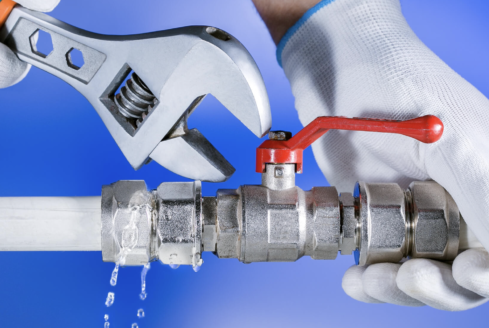From water leaks to blocked drains and burst pipes, our guide provides practical tips and insights to help you become a plumbing expert in your own home. We cover the following;
- Understanding Water Leaks: Causes, Detection, and Solutions
- Tackling Blocked Drains: DIY Techniques and When to Call a Professional
- Dealing with Burst Pipes: Emergency Steps and Long-Term Solutions
- Water Meter Installation: A Step-by-Step Guide for Accuracy and Efficiency
- Backflow Testing and Certification: Ensuring Safe Water Supply in Your Home
- Understanding Water Leaks: Causes, Detection, and Solutions
- Water leaks can cause significant damage to your home if not addressed promptly.
Water leaks can sometimes be challenging to detect. Here are some signs to look out for:
- Unexplained increase in water bills
- Damp spots or water stains on walls or ceilings
- Mold or mildew growth
Musty odors
Solutions for Water Leaks
If you discover a water leak in your home, here are some steps you can take:
- Shut off the main water supply
- Locate the source of the leak
- Repair or replace faulty fixtures or pipes
- Consider hiring a professional plumber for complex leaks
- Tackling Blocked Drains: DIY Techniques and When to Call a Professional
- Blocked drains can be a frustrating and messy problem. Understanding how to unclog drains yourself and when it’s best
- call a professional can save you time and moneyDIY Clogged Drain Techniques:
- Use a plunger
- Use a drain snake or auger
- Create a homemade drain cleaner with baking soda and vinegarClean the drain trap
When to Call the Professionals Triplumbing.
While many drain blockages can be resolved with DIY techniques, certain situations call for professional intervention:
Persistent or recurring drain blockages
Multiple clogged drains in the house
Foul smells coming from drains
Slow drainage accompanied by gurgling sounds
Dealing with Burst Pipes: Emergency Steps and Long-Term Solutions
Burst pipes are a plumbing emergency that requires immediate attention to minimize water damage and prevent further complications.

Here’s what you need to know:
Emergency Steps for Burst Pipes
Shut off the main water supply
Open all faucets to drain the water
Locate the burst pipe and assess the damage
Temporarily repair the burst pipe with a pipe clamp or rubber patch
Long-Term Solutions for Burst Pipes
Once the emergency is under control, it’s essential to address the burst pipe’s underlying causes and implement long-term solutions:
Insulate exposed pipes to prevent freezing
Replace old and corroded pipes
Maintain optimal water pressure
Regularly check for leaks and signs of damage
Water Meter Installation: A Step-by-Step Guide for Accuracy and Efficiency
Installing a water meter can help you monitor your water consumption accurately, promote water conservation, and identify any unusual usage patterns. Follow these steps for a successful installation:
Step 1: Gather the Necessary Tools and Equipment
- Water meter
- Pipe fittings
- Teflon tape
- Wrenches
- Pipe cutter
Step 2: Locate the Installation Point
Choose a suitable location for the water meter installation, usually near the main water supply entry point.
Step 3: Shut Off the Main Water Supply
Before beginning the installation process, shut off the main water supply to avoid any accidental flooding.
Step 4: Install the Water Meter
Connect the water meter to the main water supply line using the appropriate fittings and secure them tightly.
Step 5: Test for Leaks
After the installation is complete, turn on the main water supply and check for any leaks or abnormalities.
Backflow Testing and Certification: Ensuring Safe Water Supply in Your Home
Backflow occurs when the flow of water in a plumbing system reverses, allowing contaminants to enter the potable water supply. Backflow testing and certification help ensure the safety and quality of your home’s water supply.
What is Backflow?
Backflow is the undesirable reversal of water flow from a potentially polluted source into the clean water supply. This can occur due to backpressure or back-siphonage. The Importance of Backflow Testing and Certification Backflow testing and certification are essential for several reasons:
- Protection of public health and safety
- Compliance with local regulations
- Prevention of cross-contamination in plumbing systems
- Assurance of water quality
Hiring a Professional for Backflow Testing
Backflow testing requires specialized equipment and expertise. It is advisable to hire a certified backflow tester to ensure accurate and reliable results.
With the knowledge gained from this ultimate guide to plumbing services, you are now equipped to tackle common household plumbing issues with confidence. Remember to prioritize regular maintenance, address problems promptly, and seek professional help when needed. By mastering plumbing services, you can maintain a safe and efficient water supply in your home.
Backflow & household plumbing FAQs
Q: How can I prevent water leaks in my home?
A: Regularly inspect your plumbing system, address leaks promptly, and maintain optimal water pressure.
Q: Are chemical drain cleaners safe to use?
A: Chemical drain cleaners can be effective, but they may also cause damage to pipes and pose risks to your health. It’s best to use them sparingly or opt for natural alternatives.
Q: Can I fix a burst pipe myself?
A: Temporary fixes for burst pipes are possible, but it’s advisable to seek professional help for a long-term solution.
Q: How often should I have my water meter tested?
A: It is recommended to have your water meter tested annually or as per local regulations.
Q: What is the purpose of backflow prevention devices?
A: Backflow prevention devices ensure that water flows in only one direction, preventing contamination of the clean water supply.


